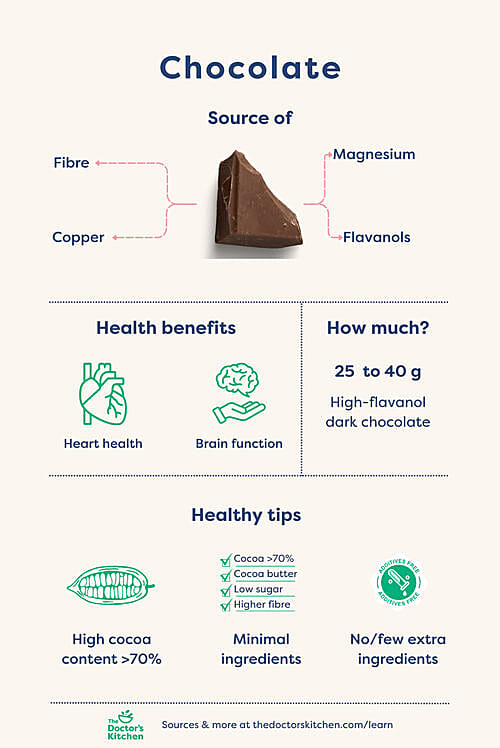Chocolate as a health food?
22nd Apr 2025
A little dark chocolate can be more than a sweet treat. If it’s made with high levels of cocoa solids, it can be a source of flavanols that support heart and brain health.
Key points
What’s in chocolate?
At its core, chocolate originates from cocoa beans, the seeds of the cacao tree. After fermentation, drying, and roasting, these beans are ground into cocoa mass, forming the foundation of all chocolate products. Cocoa is naturally rich in:
- Flavanols – Including epicatechin, catechins, and procyanidins, these antioxidant compounds are linked to various health benefits.
- Fibre – especially in minimally processed cocoa powder
- Minerals – such as magnesium, copper and iron.
- Protein – a surprising 18–20g per 100g in unsweetened cocoa powder
Health benefits of cocoa flavanols
Heart health
Cocoa flavanols help the body produce nitric oxide, which relaxes blood vessels and improves circulation. Studies have linked moderate dark chocolate intake to lower blood pressure and reduced risk of heart disease.
Brain function
Some research links cocoa flavanols to better memory and thinking skills. They support the production of nitric oxide, which improves blood flow, not just to the heart, but to the brain too. Better circulation means more oxygen and nutrients get to where they’re needed, especially in areas involved in memory and decision-making. One study even found a 41% lower risk of cognitive decline in people over 65 who consumed more.
Gut health
There’s early evidence cocoa may act like a prebiotic thanks to its fibre and polyphenols. In one trial, daily intake of 85% dark chocolate improved gut microbial diversity.
How much?
Studies suggest around 25 to 40g of dark chocolate (75 %+) a day to get a meaningful dose of flavanols. That’s a few squares – enough to enjoy, not overdo.
Just watch the sugar. The health benefits come from cocoa, not the added sugar or milk. Many commercial chocolates have very little real cocoa and lots of sugar, so choose simply made dark chocolate or try unsweetened cocoa powder in porridge or smoothies for more benefits.
How to choose quality chocolate
✔️ 75% cocoa or higher – The higher the cocoa content, the more flavanols you’re likely to get.
✔️ Minimal ingredients – Look for bars with cocoa mass or cocoa liquor and cocoa butter at the top of the list. Avoid palm oil, emulsifiers like soy lecithin or flavourings.
✔️ Traceability – Bars that list the origin of their beans often care more about quality and sourcing.
3 ways to enjoy it
- Let it melt – Good dark chocolate can taste bitter at first. But let it melt slowly and you might notice floral, fruity or earthy notes. A bit like wine or coffee, it gets more interesting the more you pay attention.
- Pair it with complementary flavours like raspberries, cherries, kiwi, coconut or nut butter.
- Cook with it – Dark chocolate is a great ingredient too. Think chocolate bark with berries, mole sauces or a square grated into porridge.

References/sources
History & cultivation: Britannica | Kew | Wellcome Collection | Jstor
Composition: Martin et al. Food and Chemical Toxicology. 2021
Cardiovascular health: Ren et al. Heart. 2019
Cognitive function: Barrera-Reyes et al. Plant Foods Hum Nutr. 2020
Gut microbiota: Shin et al. The Journal of Nutritional Biochemistry. 2022
